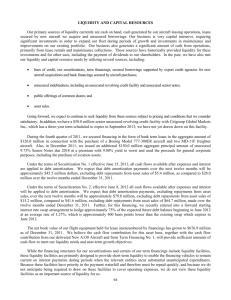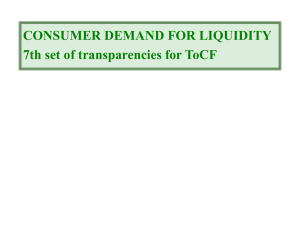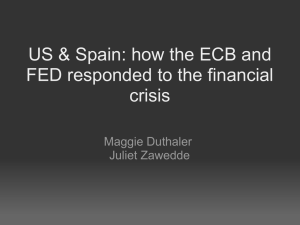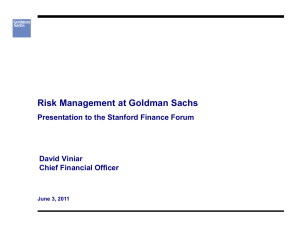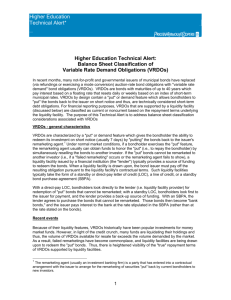TCF - set 2 - Princeton University Press
advertisement
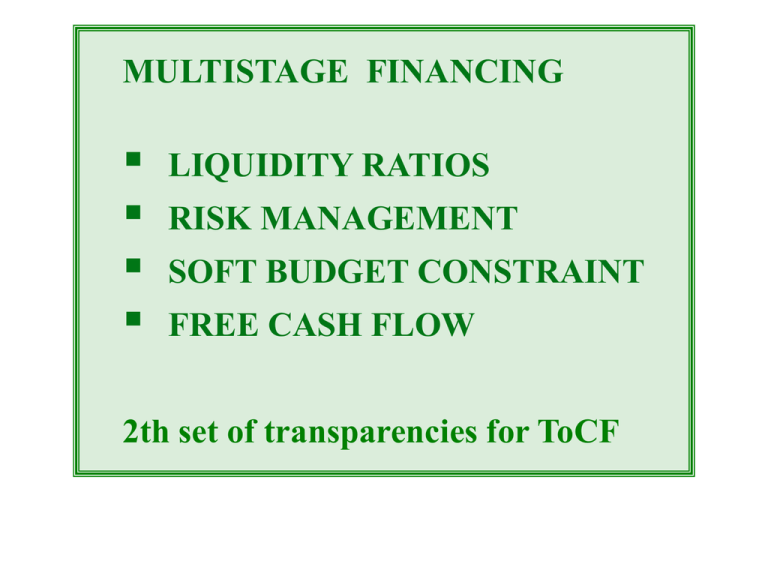
MULTISTAGE FINANCING LIQUIDITY RATIOS RISK MANAGEMENT SOFT BUDGET CONSTRAINT FREE CASH FLOW 2th set of transparencies for ToCF CORPORATE LIQUIDITY DEMAND HOARDING OF LIQUIDITY Asset side : – securities – credit lines and loan commitments Future promises to lend (maximum amount, lending terms, duration, commitment fee, option to convert into term loan at maturity?,…) Over 75% of commercial and industrial loans at large US banks = take-downs under loan commitments. Liability side : – long term debt and equity WHY? Concern about refinancing (Thakor-Hong-Greenbaum 1981, Froot2 Scharfstein-Stein 1993). CORPORATE RISK MANAGEMENT TECHNIQUES • forward/futures markets (raw materials, agricultural products), • swap FX • interest rate, • securitization, • insurance against theft, fire, death of key employee, • trade credit insurance, • geographical plant diversification. … •Yet limited hedging (Culp-Miller). Large companies make much greater use of derivatives. 3 WHY? • reduction in volatility for claimholders : No! • cut tax bill? (Stulz), • insure managers by filtering out exogenous noise (Stulz, FitePfleiderer)? Alternative : virtual hedging. • reduce probability of bankruptcy? AGENCY BASED EXPLANATIONS • unability to get funds when one needs them (Froot et al, Stulz), • avoid ancillary damages such as gambling behavior. 4 CORPORATE LIQUIDITY DEMAND "Cash poor firm" overruns/reinvestment Cash need shortfall in earnings 0 Financing 1 continue 2 Outcome Liquidation, downsizing 5 • How to meet these needs? 2 options Date 1 go to capital market : new debt, new equity DILUTION Date 0 hoard liquidity SECURITIES CONTRACT • credit line (ST) • revolving credit (often option to convert into LT loan) 6 BASIC INSIGHT:LOGIC OF CREDIT RATIONING APPLIES AT DATE 1 AS WELL WANT TO HOARD LIQUIDITY CASH RICH FIRM: flip side of same coin. Jensen 1986 ST debt Easterbrook 1984 Dividend pump out money steel, tobacco, chemical, broadcasting,... Security design also regulates liquidity Equity, LT debt: little cash draining ST debt: drains cash Preferred stocks... 7 I. LIQUIDITY RATIO AND CORPORATE RISK MANAGEMENT I. FIXED INVESTMENT VERSION Optimal policy: continue iff for some 8 (IC) 9 10 (i) (first best) (ii) Then [Third case (iii) no funding ] 11 CASH-RICH FIRM: Theory of maturity structure: Weak balance sheet short maturity structure. 12 CASH-POOR FIRM: Example: r = 0. "Wait-and-see" policy suboptimal 13 II. VARIABLE INVESTMENT VERSION 2.1 Two-shock case Timing 1 0 • • 2 Investment I Borrows I-A MH (choice pH or pL ) “INTACT” (no reinvestment needed) “DISTRESSED” (reinvestment per unit of investment) Outcome RI p 1-p 0 14 Assumptions (1) There exists store of value ( 1 (2) 1) remember (3) Interpretation 15 Policy #1 : abandon in case of distress 16 Policy #2: pursue project in case of distress Minimize cost : policy #2 1 1 Policy #2 when low high 17 2.1 Continuum-of-shocks case 0 Contract. Investment I. External financing I-A. 1 Need for cash infusion realized. Distribution pay 2 Outcome MH No money to pay pH pL p 1-p RI 0 on Project abandoned (liquidation) Yields 0 (later : yields LI) 18 a) OPTIMAL CONTRACT (later: implementation) • Only investors can cover I . • Suppose for the moment one can contract on continuation rule Optimum: continue: needs liquidate (nothing for entrepreneur) Pledgeable income after continuation 0I B p H R I p 19 IR * F ( * ) 0 I I A f ( )d I 0 multiplier I = k A k( * ) 1 1 Maximized at * 0 . * 0 f ( )d F ( * ) 0 Explanation. 20 NPV per unit of investment: maximized at Intuition. Borrower’s utility Optimum: 21 Optimal "expected unit cost of effective investment" 22 Utility: Utility = 23 Generalization: liquidation value LI : Intuition. 24 CORPORATE DEMAND FOR LIQUIDITY 1 WAIT-AND-SEE POLICY IS SUBOPTIMAL even with "perfect" financial market, investors won't bring in more than at date 1. Conversely, claims diluted. initial investors willing to have their Dilution only (even worse if debt overhang, etc.) 2 HOARDING: * Nonrevocable credit line no right to dilute or * Securities: same right to dilute 25 CORPORATE RISK MANAGEMENT with Modeling: • "Adverse" shocks (ex: foreign exchange risk). • Can get insurance at fair rate. Idea: obtain insurance so that does not mess up decision making. • HEDGING For an arbitrary Remark : could be a conditional credit line (less common). 26 NO HEDGING Firm can withstand shocks such that Hence: where Let 27 Lemma : H is more convex than F convex convex Proof : Arrow-Pratt: In contrast, manager ex post may or may not hedge if given the choice 28 Firm "risk averse" w.r.t. "risk loving" w.r.t. Mean preserving spread Firm better off DIFFERENCE: "unavoidable"; option ! 29 OPTIMALLY INCOMPLETE HEDGING Full hedging is too stark a result. Transaction costs... and 5 other reasons for hedging incompletely. (a) Market power Forward sales and over-supply by monopolist or oligopolist. (b) Several correlation of profits Example: • random short-term income r (exogenous) • "attractive-reinvestment-opportunities effect": probability of success p + (r) where ' > 0. But "easier-refinancing effect": good news make it easier to return to the capital market. 30 Optimal policy: (firm should keep some of its cash-flow as retained earnings) (c) Aggregate risk Like CAPM: economic agents share (in different proportions) the aggregate risk. (d) Asymmetric information (e) Incentives Short-term profit r in general is endogenous. Motivates investment-tocash-flow sensitivity: see next section. 31 II. SOFT BUDGET CONSTRAINT Basic idea:situation in which capital market is too soft: refinances when not ex ante optimal to do so. Date 0 Date 1 date 0 signal (or realization) moral hazard informative about (or AS) date-0 behavior about date-1 continuation income parameters r • • L • 2nd period prospects (R, pH …) want to punish if r small, etc. 32 • KEY: Monetary punishments limited (especially if continuation!) Often liquidation (interference,…) only punishment or at least complementary punishment. • EXAMPLE: r endogenous Perhaps even deterministic Low date-0 effort High date-0 effort - monetary rewards Private benefit B0I of shirking at date 0. State-invariant continuation rule does not provide incentives. Two possibilities: • very small cost (2nd order) for B0 small • not credible if 33 Text: if works if shirks MLRP : at date 0 increasing Optimal policy: over "relevant range" (small if B0 small). SBC r "retained-earnings policy" Soft Budget Constraint 34 III. FREE CASH FLOW Jensen Easterbrook • r exogenous (no SBC issue) deterministic safe cash flow (public utilities, banks, mature industries) • Generalized formulae: Free cash flow assumption: Payment: ST debt dividend (with ceiling) 35 CRITIQUES Uncertainty not flexible enough, risk of liquidity problem Ex: Rigid (ST debt): • liquidity risk (see hedging stuff) P1 high: good reinvestments not made P1 low: free cash flow • does not respond to news about L, future prospects market information ! need to make use of Secret reinvestments just before r accrues. 36



